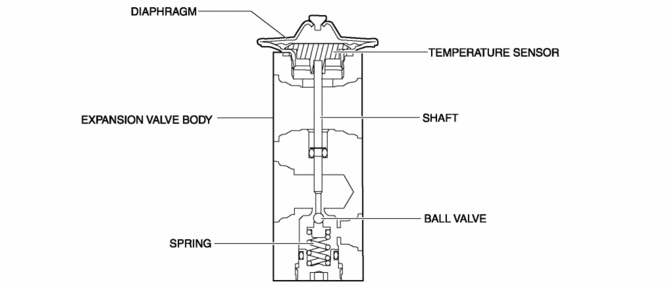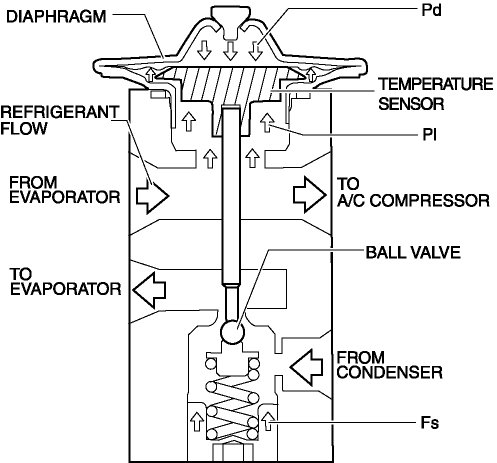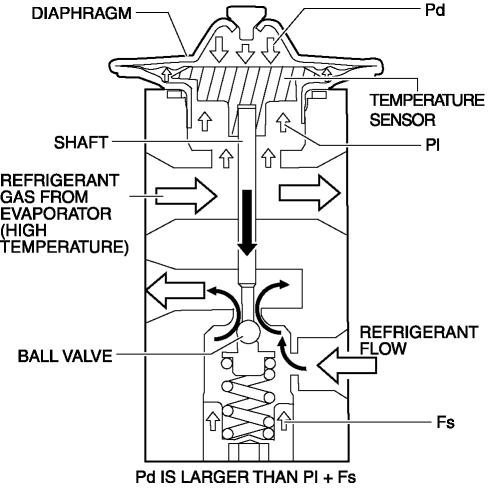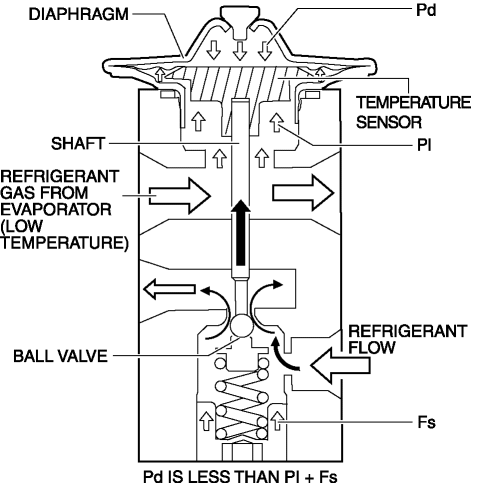Mazda CX-5 Service & Repair Manual: Expansion Valve
Purpose
-
The expansion valve atomizes liquid refrigerant to facilitate cooling of the evaporator.
Function
-
The expansion valve reduces the pressure of liquid refrigerant rapidly to facilitate vaporization of the atomized refrigerant at the evaporator, and adjusts the refrigerant amount sent into the evaporator.
Construction
-
The expansion valve consists of the following parts:
-
Diaphragm
-
Temperature sensor
-
Shaft
-
Expansion valve body
-
Ball valve
-
Spring

Operation
-
Adjustment of the refrigerant amount supplied to the evaporator is performed by the ball valve opening angle in the expansion valve.
-
The opening angle adjustment is performed according to the balance of the following forces:

-
Refrigerant pressure (Pd) in diaphragm
-
Refrigerant gas pressure (PI) of evaporator under diaphragm
-
Spring force (Fs) pushing up ball valve
-
If the refrigerant gas temperature from the evaporator increases, the expansion valve increases the amount of refrigerant according to the following operations:

-
The temperature of the temperature sensor tightly sealed against the diaphragm increases.
-
The refrigerant in the diaphragm warms and the Pd increases.
-
If this Pd increases more than PI + Fs, the diaphragm is pressed down.
-
The shaft installed to the temperature sensor end presses down the ball valve.
-
The amount of refrigerant is increased.
-
If the refrigerant gas temperature from the evaporator decreases, the expansion valve decreases the amount of refrigerant flow according to the following operation:

-
The temperature of the temperature sensor tightly sealed against the diaphragm decreases.
-
The refrigerant temperature in the diaphragm decreases and the Pd decreases.
-
The Pd decreases less than PI + Fs.
-
The ball valve installed to the temperature sensor end is pressed up.
-
The amount of refrigerant is decreased.
Fail-safe
-
Function not equipped.
 Evaporator Inspection
Evaporator Inspection
1. Inspect the evaporator for damage, cracks, and oil leakage.
If there is any malfunction, replace the evaporator.
2. Visually inspect the fins for bending.
If there is any bend ...
 Expansion Valve Removal/Installation
Expansion Valve Removal/Installation
1. Disconnect the negative battery cable..
2. Discharge the refrigerant from the system..
CAUTION:
If moisture or foreign material enters the refrigeration cycle, cooling ability
will b ...
Other materials:
Negative Battery Cable Disconnection/Connection [Skyactiv G 2.0]
WARNING:
Before removing the SRS air bag system-related parts, always disconnect the
negative battery cable and wait for 1 min. or more to allow the back-up power
supply to deplete its stored power..
Required procedure after negative battery cable disconnection/connection
...
Controller Area Network (Can) Outline
The Electric Power Steering (EPS) control module sends and receives data
to and from other modules via the CAN..
Data sent
EPS status
Power steering malfunction indicator light on request
Steering angle
Data received
Vehicle speed
Engine spe ...
Fuel Tank Pressure Sensor
Purpose/Function
The fuel tank pressure sensor detects the fuel tank pressure.
Fuel tank pressure sensor is only used for OBD.
Construction
The fuel tank pressure sensor is equipped to the charcoal canister.
A piezoelectric-type sensor has been adopted.
...
